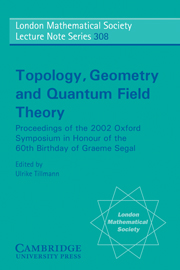 Topology, Geometry and Quantum Field Theory
Topology, Geometry and Quantum Field Theory Book contents
- Frontmatter
- Contents
- Preface
- Participants
- Introduction
- Part I Contributions
- 1 A variant of K-theory: K±
- 2 Two-vector bundles and forms of elliptic cohomology
- 3 Geometric realization of the Segal–Sugawara construction
- 4 Differential isomorphism and equivalence of algebraic varieties
- 5 A polarized view of string topology
- 6 Random matrices and Calabi–Yau geometry
- 7 A survey of the topological properties of symplectomorphism groups
- 8 K-theory from a physical perspective
- 9 Heisenberg groups and algebraic topology
- 10 What is an elliptic object?
- 11 Open and closed string field theory interpreted in classical algebraic topology
- 12 K-theory of the moduli space of bundles on a surface and deformations of the Verlinde algebra
- 13 Cohomology of the stable mapping class group
- 14 Conformal field theory in four and six dimensions
- Part II The definition of conformal field theory
- Foreword and postscript
- The definition of CFT
- References
14 - Conformal field theory in four and six dimensions
Published online by Cambridge University Press: 06 November 2009
- Frontmatter
- Contents
- Preface
- Participants
- Introduction
- Part I Contributions
- 1 A variant of K-theory: K±
- 2 Two-vector bundles and forms of elliptic cohomology
- 3 Geometric realization of the Segal–Sugawara construction
- 4 Differential isomorphism and equivalence of algebraic varieties
- 5 A polarized view of string topology
- 6 Random matrices and Calabi–Yau geometry
- 7 A survey of the topological properties of symplectomorphism groups
- 8 K-theory from a physical perspective
- 9 Heisenberg groups and algebraic topology
- 10 What is an elliptic object?
- 11 Open and closed string field theory interpreted in classical algebraic topology
- 12 K-theory of the moduli space of bundles on a surface and deformations of the Verlinde algebra
- 13 Cohomology of the stable mapping class group
- 14 Conformal field theory in four and six dimensions
- Part II The definition of conformal field theory
- Foreword and postscript
- The definition of CFT
- References
Summary
Introduction
In this paper, I will be considering conformal field theory (CFT) mainly in four and six dimensions, occasionally recalling facts about two dimensions. The notion of conformal field theory is familiar to physicists. From a mathematical point of view, we can keep in mind Graeme Segal's definition of conformal field theory. Instead of just summarizing the definition here, I will review how physicists actually study examples of quantum field theory, as this will make clear the motivation for the definition.
When possible (and we will later consider examples in which this is not possible), physicists make models of quantum field theory using path integrals. This means first of all that, for any n-manifold Mn, we are given a space of fields on Mn; let us call the fields Φ. The fields might be, for example, real-valued functions, or gauge fields (connections on a G-bundle over Mn for some fixed Lie group G), or p-forms on Mn for some fixed p, or they might be maps Φ : Mn → W for some fixed manifold W. Then we are given a local action functional I (Φ). ‘Local’ means that the Euler–Lagrange equations for a critical point of I are partial differential equations. If we are constructing a quantum field theory that is not required to be conformally invariant, I may be defined using a metric on Mn. For conformal field theory, I should be defined using only a conformal structure.
- Type
- Chapter
- Information
- Topology, Geometry and Quantum Field TheoryProceedings of the 2002 Oxford Symposium in Honour of the 60th Birthday of Graeme Segal, pp. 405 - 420Publisher: Cambridge University PressPrint publication year: 2004
- 6
- Cited by


